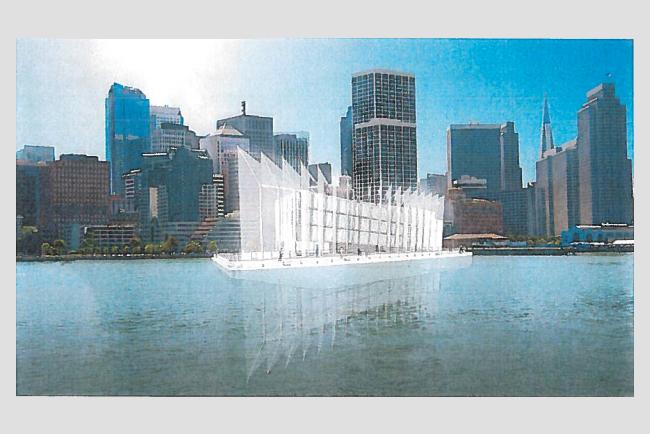
More information has emerged about Google’s barges, those once mysterious structures currently bobbing up and down in San Francisco Bay and off the coast of Maine.
Following the revelation earlier this week that they’re set to become “an interactive space where people can learn about new technology” (in other words, a showroom), documents obtained by the San Francisco Chronicle on Thursday have thrown more light on Google’s plans.
The paperwork, which had been submitted to the Port of San Francisco and obtained via a Freedom of Information Act request, includes an image (above) revealing the proposed design. The showroom section, comprising a bunch of jazzed up shipping containers, will apparently be surrounded by around 10 huge sails “reminiscent of fish fins”, with the overall design set to be an “unprecedented artistic structure …. with a bit of nautical whimsy”.

The floating showroom, which is currently docked at Treasure Island in San Francisco Bay, will be 50 feet tall and 250 feet long, the Chronicle reported.
Designed by internationally renowned architecture firms Gensler and LOT-EK, the proposal says the plan is to make the “curious and visually stunning structure….a welcome addition to the waterfront, an experience unlike any other.”
“We envisioned this space with community in mind,” barge owner and operator By and Large says in the documents, adding that its design is supposed to create “a surprising environment that is accessible to all and inspires conversation about how everything is connected — shorebirds, me, you, the sea, the fog and much more,” although our hunch is that visitors will more likely spend their time jabbering away about Google Glass.
Little is known about By and Large, though the company is reportedly the result of a project run by Google X, the secret lab operated by Google co-founder Sergey Brin that works on new ideas – Glass, as well as its self-driving car project, both emerged from the Google X lab.
Once completed, it’s expected that the barge will sail from site to site within the bay, docking for a month at a time. At some point it might “sail off to San Diego and other West Coast ports,” the Chronicle said.
The modular design also means the structure could be easily disassembled, shipped and rebuilt anywhere in the world, bringing Google’s “unprecedented artistic structure” to a much wider audience.
[Images: By and Large via Cnet]


